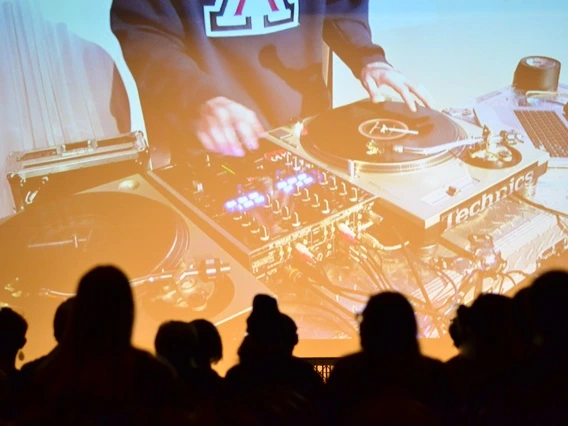
Listen to a global hip-hop playlist curated College of Humanities faculty, on YouTube or Apple Music.
Fifty years after it began in the Bronx, hip-hop has become the world’s most popular musical genre, incorporating local sounds, styles and traditions everywhere it touches.
A decade ago, the University of Arizona launched the nation’s first Minor in Hip-Hop Cultures, within the Department of Africana Studies, with several faculty members designing an interdisciplinary curriculum to introduce students to the main themes represented in hip-hop cultures: appropriation and defense of spaces, mixing of different cultures, migrations, multilingualism, race, class, gender, religions, sexuality, nationality, politics and the economy, and the search for identity.
“One of the particularities of our program is we deal with hip-hop globally. We have professors who examine artists and themes all around the world,” said Alain-Philippe Durand, Dorrance Dean of the College of Humanities. “What we see in many countries, and what the French rappers and the rest of the Francophone world were able to show, is that as people started to embrace it, they could take it to their own ends.”
As a global phenomenon, there are commonalities in the ingredients, the key elements that ignite hip-hop on a cultural level, said Durand, an expert in French hip-hop and author of several publications on the subject.
“One of the reasons hip-hop spread around the world is because those are universal themes that touch everybody, in good ways sometimes and also in negative ways. These questions of identity and immigration and those challenges are seen in many places,” Durand said. “Hip-hop gets at the central questions of humanity and the global challenges we face, like immigration, identity, poverty, freedom of expression.”
As hip-hop started spreading beyond the United States, the music and the dancing led the way. And while early rappers in other countries sometimes used English, the breakthroughs came when the artists began finding their own voices and themes.
“Once they started rapping in French, they showed the way to other places how it’s possible. If you want to pick up the microphone to be heard as far as possible, you have to do it in your language. For the lyrics, it comes from the soul. Just like the beginnings of hip-hop in the United States, rappers in France are activists as well,” Durand said. “The same way Italian is the language of opera, I believe that French was made for hip-hop. When it comes to the French language, or any romance language, with the grammar you have so many opportunities for making a play on words, or puns.”
A lot of Asian American hip-hop artists use a mixture of languages and styles, bringing traditional sounds and rhythms into their music, said Brett Esaki, Assistant Professor of Practice in the Department of East Asian Studies.
Asian and Asian American hip-hop reflect trends and themes similar to those that were driving forces at the origin of hip-hop, including both personal narratives and collective storytelling, youth protesting the older generations, and discussions about immigration and identity. Esaki quoted scholar Travis Harris, who wrote that hip-hop represents an African diasporic phenomenon, in noting that diasporic experiences can be relatable across numerous cultures.
“When that message gets out into the world, it hits people on different levels,” Esaki said. “A lot of people around the world, including in Asia, hear that struggle for survival, hear an essential reality being conveyed. That’s about truth telling and being who you are and a lot of people all over the world identify with those aspects of hip hop culture.”
In the early 2000s Religious Studies Professor Alejandro Nava introduced UArizona’s first class on hip-hop, the popular “Rap, Culture and God,” which focuses on how rap music influences cultural identity. This year, he wrote an essay for The Conversation calling hip-hop “my first love.”
“Hip-hop had its finger on the pulse of Black and brown lives on the frayed edges of the Americas, lives like my father’s and his father’s before him: cleaning trains, floors and toilets, doing whatever they could to support their families,” he wrote. “Whether in the South Bronx or East L.A., brown-bodied youth embraced hip-hop as an ingenious instrument of self-expression: a perfect medium to assert, define and even reinvent ourselves.”
The author of two books about the connections between spirituality and hip-hop, Nava wrote that after 50 years, hip-hop retains its core essence even as its contributions to society and culture expands.
“Hip-hop continues to be a powerful amulet against powers that try to silence the young and underprivileged. It’s eloquent proof of an enduring truth: that hardship can fuel ingenuity and cunning, and that poetry can be fashioned out of society’s scraps,” he wrote.
As part of this year’s Tucson Humanities Festival, faculty DJs selected hip-hop tracks from around the world, showcasing how the music has spread across countries, continents and cultures. The song selections demonstrated both the internationalization of hip-hop and how hip-hop has blended with and incorporated various traditions, both musical and cultural, as it’s conquered the world.
Anastasia Gordienko, Assistant Professor of Russian and Slavic Studies, who curated a selection of Ukrainian and Russian hip-hop songs, said artists commonly use their music as a means of social protest and are outspoken about issues like corruption and social problems.
“Ukrainian rap and hip-hop have gained significant popularity in recent years, blending powerful lyrics with folkloric motifs that reflect the country’s rich cultural heritage. This music incorporates thought-provoking lyrics to address topics such as inequality, government actions, and significant political events like the Euromaidan revolution and Russia’s invasion of Ukraine,” she said. “Similarly influential genres in Russia, rap and hip-hop have become favorites among the youth due to their contemporary beats and their ability to challenge the status quo. Some popular Russian rappers have faced persecution for their criticism of Putin’s politics, and now are living and rapping in exile."

